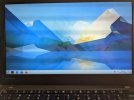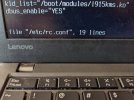Yeah. I was hoping you'll look at more than one such article, but even this was a useful exercise in doing research and connecting the dots back to your FreeBSD adventures.

I will try to read more about TWM once I get KDE set up. It does seem interesting, but right now all I can think about is getting KDE set up.
While those instructions are not harmful per se i believe that tutorials should be as short as possible and focus on the necessary steps. Maybe people know that these modules get started while booting and are confused and wonder why you start them beforehand.
Upon further reflection, I think you were in the right, and I was in the wrong. I am going to amend my instructions (see Rough Draft #5 below) to say those two instructions are not necessary. With that said, I am still going to do the instructions myself -- even though I'm sure 99% of FreeBSD users would not. This is because I am overly cautious and want to do everything I can to make sure everything is loaded and works. Keeping the instructions in the rough draft -- though saying they are not necessary -- is mostly just for myself, but maybe other people will find seeing those steps mentioned and
why they don't need to be followed helpful. Thank you for your concern.
--
I think I am going to attempt to install KDE now because tonight is the
longest lunar eclipse in 580 years. (I know, I'm weird.) How do I take a screenshot once I get into KDE (so I can post it here)?
--
Instructions for Installing KDE on FreeBSD (Rough Draft #5)
In this fifth rough draft of instructions, I will show you how to install KDE that will be started with the command startx. My second rough draft of instructions should not be followed because steps I20-I23 are not edited from a usr account (i.e. they should not be edited as root). The third rough draft of instructions should also not be followed because steps J23-J27 should be merged with step J4. The fourth rough draft is mostly correct; this fifth rough draft makes minor edits to L7, L8, and L13. My first rough draft of instructions shows you how to install KDE that is started by sddm. Thanks go to astyle for ironing out the final details and everyone else who contributed on The FreeBSD Forums.
L1. Enter the superuser/root account by entering
% su and the password for the root account. Note that the command prompt on the shell (
%,
$,
#, etc.) is dependent on what user is currently logged in. Therefore, the
% should not actually be typed out. Once in the root account, the command prompt will be
#.
L2. Run
# pkg install drm-kmod
L3. Enter the easy editor to edit the file
/etc/rc.conf by entering the following command:
# ee /etc/rc.conf
L4. Once in the easy editor, on a new line, enter the following two lines on separate lines:
Code:
kld_list="/boot/modules/i915kms.ko"
dbus_enable="YES"
L5. Make sure to hit
Enter so the file starts on a new line after saving.
L6. Save and exit the easy editor by pushing
Esc and following the prompts to save and exit. The KMS driver should now be set up.
L7. (L7 and L8 are superfluous if you reboot in step L10.
i915kms and
dbus get loaded while booting because you added them to
/etc/rc.conf in L4. In other words, you can skip L7 and L8. I am still including the steps for future reference.) Go ahead and load the drm driver. Run
# kldload /boot/modules/i915kms.ko
L8. (L7 and L8 are superfluous if you reboot in step L10.
i915kms and
dbus get loaded while booting because you added them to
/etc/rc.conf in L4. In other words, you can skip L7 and L8. I am still including the steps for future reference.) Run
# service dbus start
L9. Run
# pkg install xorg
L10. Reboot by running
# shutdown -r now and booting up to a command-line login prompt.
L11. Log in as regular user (this is important).
L12. Run
% startx as regular user (Even the Handbook tells you to do that, the
Quick Start section 5.4.1, Step 3.)
L13. TWM window manager will start. You can return to text mode by opening the pop-up menu by left-clicking on the desktop and then clicking
Exit.
L14. Become the superuser/root account again by running
% su
L15. Reboot by running
# shutdown -r now
L16. After logging in, become the superuser/root account again by running
% su
L17. Run
# pkg install kde5 firefox
L18. Enter the easy editor to edit the file
/etc/fstab by entering the following command:
# ee /etc/fstab
L19. Once in the easy editor, on new lines, enter the following two lines (you can push the
Tab key or spacebar after entering each field):
fdesc /dev/fd fdescfs rw 0 0
proc /proc procfs rw 0 0
(See
post #33. There is debate on whether this instruction should be included; I am including it because it may be beneficial for those who want to run applications such as LibreOffice.)
L20. Make sure to hit
Enter so the file starts on a new line after saving.
L21. Save and exit the easy editor by pushing
Esc and following the prompts to save and exit.
L22. Run
# mount /dev/fd
L23. Run
# mount /proc
L24. Exit the superuser account by running
# exit. All files in your $HOME directory should be edited as a regular user, not as root.
L25. Enter the easy editor to edit the file
~/.xinitrc by entering the following command:
% ee ~/.xinitrc
L26. Once in the easy editor, on a new line, enter the following line:
Code:
exec ck-launch-session startplasma-x11
L27. Make sure to hit
Enter so the file starts on a new line after saving.
L28. Save and exit the easy editor by pushing
Esc and following the prompts to save and exit.
L29. Become the superuser/root account again by running
% su
L30. Reboot by running
# shutdown -r now
L31. If you chose not to reboot, enter
# exit to leave the superuser account.
L32. If everything worked, you should see the KDE desktop after running
% startx as a regular account.






